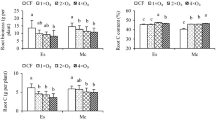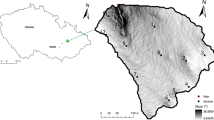Abstract
An experiment, focusing on the effects of chronically enhanced O3 regimes on young beech (Fagus sylvatica) and on the microbial rhizosphere community structure, was conducted from November 2002 to August 2006 in eight field lysimeters at the Helmholtz Zentrum München. The instrumentations of the lysimeters enabled the establishment of the water balance in the unsaturated zone and the assessment of the water uptake by plants. Further, the containment provided by the lysimeters made it possible to apply a root rot pathogen infection without contaminating the surrounding soil. A free-air fumigation system allowed to double the O3 concentration in the air above four lysimeters relative to the ambient air. To avoid damage of the leaves the maximum O3 concentration was limited to 150 nL L−1. For nearly 70% of the time the set-point concentration was reached within 10%. In the final harvest the whole soil column was retrieved and a nearly complete data-set of above-ground and below-ground parameters became available.











Similar content being viewed by others
References
Andersen CP (2003) Source-sink balance and carbon allocation below ground in plants exposed to ozone. New Phytol 157:213–228, doi:10.1046/j.1469-8137.2003.00674.x
Ashmore MR (2005) Assessing the future global impacts of ozone on vegetation. Plant Cell Environ 28:949–964, doi:10.1111/j.1365-3040.2005.01341.x
Benton J, Fuhrer J, Gimeno BS, Skärby L, Palmer-Brown D, Ball G, Roadknight C, Mills G (2000) An international cooperative programme indicates the widespread occurrence of ozone injury on crops. Agric Ecosyst Environ 78:19–30, doi:10.1016/S0167-8809(99)00107-3
Calatayud A, Alvarado JW, Barreno E (2002) Effects of ozone concentration on cabbage (Brassica oleracea L.) in a rural mediterranean environment. Phyton 42:29–33
Castagna A, Nali C, Ciompi S, Lorenzini G, Soldatini GF, Ranieri A (2001) Ozone exposure affects photosynthesis of pumpkin (Cucurbita pepo) plants. New Phytol 152:223–229, doi:10.1046/j.0028-646X.2001.00253.x
Erwin DC, Ribeiro OK (1996) Phytophthora diseases worldwide. APS Press, St. Paul
Esperschütz J, Gattinger A, Buegger F, Lang H, Munch JC, Schloter M, Winkler JB (2009a) A continuous labelling approach to recover photosynthetically fixed carbon in plant tissue and rhizosphere organisms of young beech trees (Fagus sylvatica L.) using stable isotopes technology. Plant Soil (this issue)
Esperschütz J, Pritsch K, Gattinger A, Winkler JB, Buegger F, Munch JC, Schloter M (2009b) Influence of chronic ozone stress on carbon translocation processes into rhizosphere microbial communities of beech trees (Fagus sylvatica L.) during a growing season. Plant Soil (in press)
Fleischmann F, Schneider D, Matyssek R, Oßwald W (2002) Investigations on net CO2 assimilation, transpiration and root growth of Fagus sylvatica infested with four different Phytophthora species. Plant Biol 4:144–152, doi:10.1055/s-2002–25728
Fleischmann F, Göttlein A, Rodenkirchen H, Lütz C, Oßwald W (2004) Biomass, nutrient and pigment content of beech (Fagus sylvatica) saplings infected with Phytophthora citricola, P. cambivora, P. undulata. For Path 34:79–92
Fleischmann F, Koehl J, Portz R, Beltrame AB, Oßwald W (2005) Physiological changes of Fagus sylvatica seedlings infected with Phytophthora citricola and the contribution of its elicitin “citricolin” to pathogenesis. Plant Biol 7:650–658, doi:10.1055/s-2005-872891
Fleischmann F, Winkler JB, Oßwald WF (2009) Effects of ozone and Phytophthora citricola on non-structural carbohydrates of European beech (Fagus sylvatica) saplings. Plant Soil, doi:10.1007/s11104-009-9927-y
Fuhrer J, Booker F (2003) Ecological issues related to ozone: agricultural issues. Environ Int 29:141–154, doi:10.1016/S0160-4120(02)00157-5
Gayler S, Klier C, Müller CW, Weiss W, Winkler JB, Priesack E (2009) Analysing the role of soil properties, intitial biomass and ozone on observed variability of plant growth in a lysimeter study. Plant Soil (this issue)
Hendrey GR, Lewin K, Nagy J (1993) Control of carbon dioxide in unconfined field plots. In: Schulze E-D, Mooney HA (eds) Design and execution of experiments on CO2 enrichment, vol. 6. Commision of the European Communities, Brussels, pp 309–326
Karnosky DF, Gielen B, Ceulemans R, Schlesinger WH, Norby RJ, Oksanen E, Matyssek R, Hendrey GR (2001) FACE systems for studying the impacts of greenhouse gases on forest ecosystem. In: Karnosky DF, Ceulemans R, Scarascia-Mugnozza G, Innes JL (eds) The impact of carbon dioxide and other greenhouse gases on forest ecosystems Report No3 of the IUFRO task force on environmental change. CAB International, Oxon, NY, pp 297–324
Karnosky DF, Pregitzer KS, Zak DR, Kubiske ME, Hendrey GR, Weinstein D, Nosal M, Percy KE (2005) Scaling ozone responses of forest trees to the ecosystem level in a changing climate. Plant Cell Environ 28:965–981, doi:10.1111/j.1365-3040.2005.01362.x
Karnosky DF, Werner H, Holopainen T, Percy KE, Oksanen T, Oksanen E, Heerdt C, Fabian P, Nagy J, Heilman W, Cox R, Nelson N, Matyssek R (2007) Free-air exposure systems to scale up ozone research to mature trees. Plant Biol 9:181–190, doi:10.1055/s-2006-955915
King JS, Kubiske ME, Pregitzer KS, Hendrey GR, McDonald EP, Giardina CP, Quinn VS, Karnosky DF (2005) Tropospheric O3 compromises net primary production in young stands of trembling aspen, paper birch and sugar maple in response to elevated atmospheric CO2. New Phytol 168:623–636, doi:10.1111/j.1469-8137.2005.01557.x
Kolb TE, Matyssek R (2001) Limitations and perspectives about scaling ozone impacts in trees. Environ Pollut 115:373–393, doi:10.1016/S0269-7491(01)00228-7
Kozovits AR, Matyssek R, Blaschke H, Göttlein A, Grams TEE (2005a) Competition increasingly dominates the responsiveness of juvenile beech and spruce to elevated CO2 and/or O3 concentrations throughout two subsequent growing season. Glob Change Biol 11:1387–1401, doi:10.1111/j.1365-2486.2005.00993.x
Kozovits AR, Matyssek R, Winkler JB, Göttlein A, Blaschke H, Grams TEE (2005b) Above-ground space sequestration determines competitive success in juvenile beech and spruce trees. New Phytol 167:181–196, doi:10.1111/j.1469-8137.2005.01391.x
Kreutzer K, Bittersohl J (1986) Untersuchungen über die Auswirkungen des sauren Regens und der kompensatorischen Kalkung im Wald. Forstwiss Centbl 105:273–282, doi:10.1007/BF02741727
Löw M, Herbinger K, Nunn AJ, Häberle K-H, Leuchner M, Heerdt C, Werner H, Wipfler P, Pretzsch H, Tausz M, Matyssek R (2006) Extraordinary drought of 2003 overrules ozone impact on adult beech trees (Fagus sylvatica). Trees (Berl) 20:539–548, doi:10.1007/s00468-006-0069-z
Luedemann G, Matyssek R, Fleischmann F, Grams TEE (2005) Acclimation to ozone affects host/pathogen interaction and competitiveness for nitrogen in juvenile Fagus sylvatica and Picea abies trees infected with Phytophthora citricola. Plant Biol 7:640–649, doi:10.1055/s-2005-872902
Luster J, Menon M, Hermle S, Schulin R, Günthardt-Goerg MS, Nowack B (2008) Initial changes in refilled lysimeters built with metal polluted topsoil and acidic or calcareous subsoils as indicated by changes in drainage water composition. Water Air Soil Pollut Focus 8:163–176
Manning WJ (2005) Establishing a cause and effect relationship for ambient ozone exposure and tree growth in the forest progress and an experimental approach. Environ Pollut 137:443–454, doi:10.1016/j.envpol.2005.01.031
Matamala R, Gonzàlez-Meler MA, Jastrow JD, Norby RJ, Schlesinger WH (2003) Impacts of fine root turnover on forest NPP and soil C sequestration potential. Science 302:1385–1387, doi:10.1126/science.1089543
Matyssek R (2001) How sensitive is birch to ozone? Responses in structure and function. J For Sci 47:8–20
Matyssek R, Sandermann H (2003) Impact of ozone on trees: An ecophysiological perspective. In: Esser K, Lüttge U, Beyschlag W, Hellwig F (eds) Progress in botany, vol. 64. Springer, Berlin, pp 349–404
Matyssek R, Agerer R, Ernst D, Munch J-C, Oßwald W, Pretzsch H, Priesack E, Schnyder H, Treutter D (2005) The plant’s capacity in regulating resource demand. Plant Biol 7:560–580, doi:10.1055/s-2005-872981
Matyssek R, Bahnweg G, Ceulemans R, Fabian P, Grill D, Hanke DE, Kraigher H, Oßwald W, Rennenberg H, Sandermann H, Tausz M, Wieser G (2007) Synopsis of the CASIROZ case study: carbon sink strength of Fagus sylvatica L. in a changing environment—experimental risk assessment of mitigation by chronic ozone impact. Plant Biol 9:163–180, doi:10.1055/s-2007-964883
Meissner R, Rupp H, Seyfahrt M (2008) Advances in out door lysimeter techniques. Water Air Soil Pollut Focus 8:217–225, doi:10.1007/s11267-007-9166-2
Nunn AJ, Reiter IM, Häberle K-H, Werner H, Langebartels C, Sandermann H, Heerdt C, Fabian P, Matyssek R (2002) “Free-Air” ozone canopy fumigation in an old-growth mixed forest: concept and observations in beech. Phyton 42:105–119
Nunn AJ, Kozovits AR, Reiter IM, Heerdt C, Leuchner M, Lutz C, Liu X, Löw M, Winkler JB, Grams TEE, Häberle K-H, Werner H, Fabian P, Rennenberg H, Matyssek R (2005) Comparison of ozone uptake and sensitivity between a phytotron study with young beech and a field experiment with adult beech (Fagus sylvatica). Environ Pollut 137:494–506, doi:10.1016/j.envpol.2005.01.036
Nunn AJ, Wieser G, Reiter IM, Häberle K-H, Grote R, Havranek WM, Matyssek R (2006) Testing the unifying theory of ozone sensitivity with mature trees of Fagus sylvatica and Picea abies. Tree Physiol 26:1391–1403
Oksanen E, Kontunen-Soppela S, Riikonen J, Peltonen P, Uddling J, Vapaavuori E (2007) Northern environment predisposes birches to ozone damage. Plant Biol 9:191–196, doi:10.1055/s-2006-924176
Oßwald W, Koehl J, Heiser I, Nechtwatal J, Fleischmann F (2004) New insights in the genus Phytophthora and current diseases these pathogens cause in their ecosystem. In: Esser K, Lüttger U, Beyschlag W, Murata J (eds) Progress in botany, vol. 65. Springer, Berlin, pp 436–466
Paoletti E, Grulke NE (2005) Does living in elevated CO2 ameliorate tree response to ozone? A review on stomatal respones. Environ Pollut 137:483–493, doi:10.1016/j.envpol.2005.01.035
Pendall E, Leavitt SW, Brooks T, Kimball BA, Pinter PJ, Wall GW, LaMorte RL, Wechsung F, Adamsen FJ, Matthias AD, Thompson TL (2001) Elevated CO2 stimulates soil respiration in a FACE wheat field. Basic Appl Ecol 2:193–201, doi:10.1078/1439-1791-00053
Pepin S, Körner C (2002) Web-FACE: a new canopy free-air CO2 enrichment system for tall trees in mature forests. Oecologia 133:1–9, doi:10.1007/s00442-002-1008-3
Pritsch K, Ernst D, Fleischmann F, Gayler S, Grams TEE, Göttlein A, Heller W, Koch N, Lang H, Matyssek R, Munch JC, Olbrich M, Scherb H, Stich S, Winkler JB, Schloter M (2008) Plant and soil system responses to ozone after 3 years in a lysimeter study with juvenile beech (Fagus sylvatica L.). Water Air Soil Pollut Focus 8:139–154, doi:10.1007/s11267-007-9164-4
Reich PB (1987) Quantifying plant response to ozone: a unifying theory. Tree Physiol 3:63–91
Reth S, Graf W, Gefke O, Schilling R, Seidlitz HK, Munch JC (2008) Whole-year-round observation of N2O profiles in soil: a lysimeter study. Water Air Soil Pollut Focus 8:129–137, doi:10.1007/s11267-007-9165-3
Royal Society (2008) Ground-level ozone in the 21st century: future trends, impacts and policy implications. Science Policy Report 15/08. The Royal Society, London, p 132
Samuelson L, Kelly JM (2001) Scaling ozone effects from seedlings to forest trees. New Phytol 149:21–41, doi:10.1046/j.1469-8137.2001.00007.x
Schloter M, Winkler JB, Aneja M, Fleischmann F, Pritsch K, Heller W, Stich S, Grams TEE, Göttlein A, Matyssek R, Munch J-C (2005) Short-term effects of ozone on the plant–rhizosphere–bulk soil system of young beech trees. Plant Biol 7:728–736, doi:10.1055/s-2005-872987
Seyfahrt M, Reth S (2008) Lysimeter Soil Retriever (LSR)—an application of a new technique for retrieving soils from lysimeters. Water Air Soil Pollut Focus 8:227–231, doi:10.1007/s11267-007-9161-7
Unhold VG, Fank J (2008) Modular design of field lysimeters for specific applications needs. Water Air Soil Pollut Focus 8:233–242
Volk M, Geissmann M, Blatter A, Contat F, Fuhrer J (2003) Design and performance of a free-air exposure system to study long-term effects of ozone on grasslands. Atmos Environ 37:1341–1350, doi:10.1016/S1352-2310(02)01012-9
Werner H, Fabian P (2002) Free-air fumigation of mature trees: A novel system for controlled ozone enrichment in grown-up beech and spruce canopies. Environ Sci Pollut Res 9:117–121, doi:10.1007/BF02987458
Winkler JB, Fleischmann F, Gayler S, Scherb H, Matyssek R, Grams TEE (2009) Do chronic aboveground D3 exposure and belowground pathogen stress affect growth and belowground biomass partitioning of juvenile beech trees (Fagus sylvatica L.)? Plant Soil (this issue)
Wittig VE, Ainsworth EA, Long SP (2007) To what extent do current and projected increases in surface ozone affect photosynthesis and stomatal conductance of trees? A meta-analytic review of the last 3 decades of experiments. Plant Cell Environ 30:1150–1162, doi:10.1111/j.1365-3040.2007.01717.x
Acknowledgements
This work was supported in parts by the German Research foundation (DFG) through the ‘Sonderforschungsbereich’ (SFB) 607. The authors would like to thank H.-D. Payer for his engagement to realise the experiment and O. Gefke, P. Bader, D. Schneider, M. Kugelmann and the technical staff from the Department of Environmental Engineering for their valuable support during the experiment.
Author information
Authors and Affiliations
Corresponding author
Additional information
Responsible Editor: Per Ambus.
Rights and permissions
About this article
Cite this article
Winkler, J.B., Lang, H., Graf, W. et al. Experimental setup of field lysimeters for studying effects of elevated ozone and below-ground pathogen infection on a plant-soil-system of juvenile beech (Fagus sylvatica L.). Plant Soil 323, 7–19 (2009). https://doi.org/10.1007/s11104-009-9936-x
Received:
Accepted:
Published:
Issue Date:
DOI: https://doi.org/10.1007/s11104-009-9936-x




